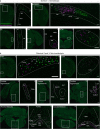A transcriptomic taxonomy of mouse brain-wide spinal projecting neurons
- PMID: 38092914
- PMCID: PMC10719099
- DOI: 10.1038/s41586-023-06817-8
A transcriptomic taxonomy of mouse brain-wide spinal projecting neurons
Abstract
The brain controls nearly all bodily functions via spinal projecting neurons (SPNs) that carry command signals from the brain to the spinal cord. However, a comprehensive molecular characterization of brain-wide SPNs is still lacking. Here we transcriptionally profiled a total of 65,002 SPNs, identified 76 region-specific SPN types, and mapped these types into a companion atlas of the whole mouse brain1. This taxonomy reveals a three-component organization of SPNs: (1) molecularly homogeneous excitatory SPNs from the cortex, red nucleus and cerebellum with somatotopic spinal terminations suitable for point-to-point communication; (2) heterogeneous populations in the reticular formation with broad spinal termination patterns, suitable for relaying commands related to the activities of the entire spinal cord; and (3) modulatory neurons expressing slow-acting neurotransmitters and/or neuropeptides in the hypothalamus, midbrain and reticular formation for 'gain setting' of brain-spinal signals. In addition, this atlas revealed a LIM homeobox transcription factor code that parcellates the reticulospinal neurons into five molecularly distinct and spatially segregated populations. Finally, we found transcriptional signatures of a subset of SPNs with large soma size and correlated these with fast-firing electrophysiological properties. Together, this study establishes a comprehensive taxonomy of brain-wide SPNs and provides insight into the functional organization of SPNs in mediating brain control of bodily functions.
© 2023. The Author(s).
Conflict of interest statement
Z.H. is an advisor of SpineX, Life Biosciences, and Myro Therapeutics. H.Z. is on the scientific advisory board of MapLight Therapeutics, Inc. The remaining authors declare no competing interests.
Figures




























Comment in
-
Cellular atlases of the entire mouse brain.Nature. 2023 Dec;624(7991):253-255. doi: 10.1038/d41586-023-03781-1. Nature. 2023. PMID: 38092903 No abstract available.
References
Publication types
MeSH terms
Substances
Grants and funding
LinkOut - more resources
Full Text Sources
Molecular Biology Databases
Research Materials

